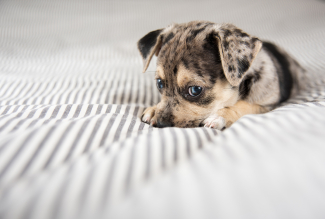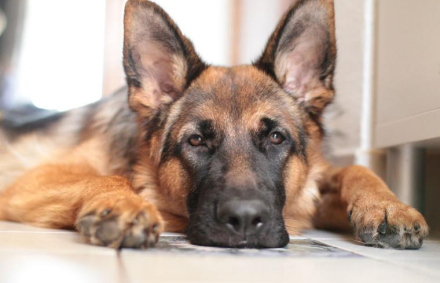
Have fleas overrun your pet? It's more than likely that they've also taken over their favourite corners. Unfortunately, no matter how many baths you give and insecticides you apply to your dog, you won't kill them off. The fleas are not going to go away until you rid the environment of their eggs, larvae and pupae.
There's nothing more frustrating than seeing fleas returning again and again and making our pets suffer. All too often we target the adult insect, when actually, the main problem is the immature forms: eggs, larvae and pupae.
Read on and find out how to get rid of the eggs once and for all.
A contaminated house
Flea eggs make up approximately 50% of the infestation. Over the course of its life, an adult flea can lay hundreds to thousands of them on your pet. White or translucent in colour, and tiny as a grain of sand, they fall off the animal's fur and contaminate its environment. They're so small they're difficult to see with the naked eye and are often mistaken for dandruff.
It's also easy to mistake the eggs for flea dirt, reddish or blackish specks that are actually the faeces of the adult forms — and the larvae's favourite food. The dirt is much easier to see than the eggs and is a sure indicator of infestation. Do the test! Comb your pet, lay the debris on a tissue and put a drop of water on the black spots: if a reddish halo forms, you have a flea problem in your house.
Cleanliness of the environment: key to treatment
Flea treatments fail because we don't attack the root of the problem: the eggs. To eliminate them from your house, the first step is to wash the bed covers and cushions where your pet usually sleeps, not forgetting their toys. The best thing is to put everything in the washing machine at the maximum temperature the fabric allows: this way, you'll get rid of both the adult and immature forms. You may need to do several washes, so prepare to be patient.
For floors and corners, the vacuum cleaner is our best aid for getting rid of the troublesome eggs. The secret is to vacuum in all the right places. Hint: carpets are often their favourite hiding place. Vacuuming is also effective on wooden and laminate floors, as the small cracks between the boards are like luxury hotels for these insects. On tile floors, mopping with soap will help keep the area free of parasites.
Also, pay extra attention to places where dust and dirt can easily accumulate. For example, clean under rugs, armchairs, furniture and sofa cushions, as well as in corners or on skirting boards.
Shaggy carpets, cracked floors or rooms cluttered with furniture and other furnishings pose the biggest challenge to your cleaning efforts.
At first, you need to vacuum frequently, even several times a day in the most severe cases. Further on, every three days should be enough. Once you see that the fleas have stopped harassing your faithful companion (usually, when they no longer have fleas, they stop scratching), you should still vacuum at least weekly. Of course, there's not much point in vacuuming without having applied some treatment to your pet, preferably a spot-on pipette combined with a flea collar, which needs to be kept on 24 hours a day, and not only when it has fleas, but all year round in order to stay protected. The reason is simple: the vibration of the vacuum cleaner makes the pupae come out of their cocoons and, if your furry friend is not protected, hundreds of adult fleas could give them a nasty surprise...
Some people recommend discarding the vacuum cleaner bag immediately, to prevent fleas from continuing to develop inside and somehow finding their way back into your house. Although there's no clear evidence that this happens, it wouldn't do any harm to put a few mothballs inside the appliance for your peace of mind!
Stop the eggs developing with IGR molecules
As we've been saying, insecticides kill adult fleas, but are not effective against immature forms. To deal with these, you need another ally: an IGR molecule that stops them from developing. These substances are very safe for you and your four-legged friend, but terrible against fleas, as they break their life cycle.
These molecules can be administered topically onto your pet's fur, or orally as a tablet. However, the easiest and most effective way is by means of a spot-on pipette applied periodically. The best ones, like Dynacan, contain an IGR molecule and a potent insecticide. The main value of using this combination is that the eggs that fall off a dog treated with Dynacan will no longer be able to develop, so the environmental contamination is eliminated. In other words, this treatment fights both the adult fleas and immature forms at the same time. It can be applied in a jiffy and protects your pet for 8 weeks. It's that easy!
Stop your house from being contaminated again
The keys to success when treating fleas are patience and perseverance. The last thing you want is for your pets to be pestered by these creatures again. Remember that a flea can lay up to 2,000 eggs in its lifetime. Just one is enough to turn a nuisance into a severe infestation!
If you want to keep them well away from your home, use spot-on pipettes and flea collars. This will prevent immature forms from developing, eliminate the adults and repel the new ones. But do be careful, don't forget that some treatments cannot be used on cats. Always consult your vet.
So, now you know, flea eggs are an invisible menace. With cleanliness and Dynacan, you can wave the problem goodbye.



